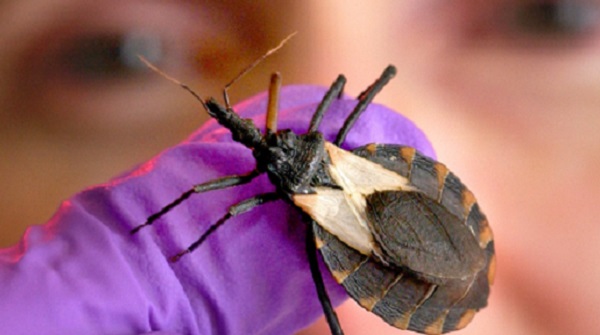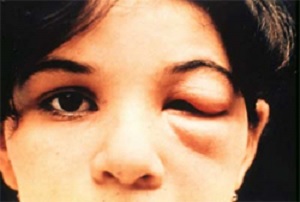Key points
- Chagas disease is caused by the parasite Trypanosoma cruzi. It usually spreads through contact with triatomine bugs.
- Chagas disease is most common in rural areas of Mexico and Central and South America.
- The early stage, or acute infection, of Chagas disease often has mild symptoms or goes unnoticed. Chronic infection can lead to serious heart and digestive system issues.
- Early diagnosis and treatment can be lifesaving.

Overview
Chagas disease is a condition caused by the parasite Trypanosoma cruzi. The parasite is mainly found in rural areas of Mexico and Central and South America. Triatomine bugs can carry this parasite and infect people and animals. About 8 million people globally, including an estimated 280,000 in the United States, have this disease, often without knowing it. Without treatment, it can be life-threatening. Movement of people living with Chagas disease from rural areas to cities and other countries has changed where we find Chagas disease. In places like the United States, where Chagas disease is present but is not regularly spread by Triatomine bugs, it is important to recognize infection and prevent its spread through blood transfusion, organ transplants, and from pregnant women to their babies.
Signs and symptoms

A symptom of Chagas disease is Romaña's sign—when the eyelid swells up. This happens when the Trypanosoma cruzi parasite gets into the eyelid, usually by accidentally rubbing the bug feces (poop) into your eye or into a bug bite near your eye.
Chagas disease has two stages. The first stage, called the acute phase, happens shortly after infection. The second stage, known as the chronic phase, occurs over a long time. In both stages, some people might not feel sick at all, while others can have serious health problems.
Acute phase: This early stage happens in the first weeks or months after getting infected. Symptoms are often mild or not there at all and can include:
- Fever
- Feeling tired
- Body aches
- Headache
- Rash
- Loss of appetite
- Diarrhea
- Vomiting
- Eyelid swelling (Romaña's sign)
Chronic phase: This stage can last many years or even a lifetime. Most people have no symptoms during this time. However, about 20 – 30% of those infected develop serious problems. These include:
- Heart issues, such as an enlarged heart, heart failure, altered heart rate or rhythm, or sudden death.
- Digestive problems, such as an enlarged esophagus or colon, leading to trouble eating or going to the bathroom.
Risk factors
If a family member has Chagas disease, you and your family should consider testing, especially if:
- You might have been exposed in the same way, for example because you lived in rural parts of Mexico or Central or South America
- Your mother was diagnosed or infected
Chagas disease can also spread through:
- A pregnant woman to her baby
- Blood transfusions
- Organ transplants
- Consuming uncooked food contaminated with feces from infected bugs
- Accidental exposure in a lab
Mothers with Chagas disease can usually breastfeed safely. But, if a mother has cracked nipples or blood in her breast milk, it is best to pump and throw away the milk until her nipples heal and the bleeding stops.
Chagas disease does not spread from person-to-person like a cold or the flu. It also does not spread through casual contact with people or animals who are infected.
In some parts of Latin America, programs targeting kissing bugs have effectively stopped the disease's spread.
How it spreads
Chagas disease spreads as follows:
- The kissing bug, also known as triatomine bug, bites and sucks blood from infected animals or people. This is how the bug gets the T. cruzi parasites.
- After biting, bugs pass the parasite in their droppings. If these droppings get into someone's body through a cut in the skin, or near the eyes or mouth, it can lead to infection.
- People might scratch or rub bug feces into a bite wound, their eyes, or mouth without realizing it, which allows the parasite to enter their body.
Prevention
If you are traveling or visiting rural areas that might have Chagas disease, be sure to:
- Stay in well-built places (like air-conditioned or screened hotel rooms). This lowers the risk of contact with infected kissing bugs, which often live in poorly built dwellings and are active at night.
- Spray the places where you're staying with long-lasting insecticides.
- Sleep under bed nets treated with long-lasting insecticide.
- Wear clothing that covers your skin and use bug spray on skin that's exposed.
- Do not eat salads, raw vegetables, unpeeled fruits, and unpasteurized fruit juices.
Remember, there are no vaccines or drugs that can prevent Chagas disease at this time.
Diagnosis
Only a healthcare provider can diagnose Chagas disease. Lab tests can confirm Chagas disease using a small sample of your blood. If you have symptoms of Chagas disease, talk with your healthcare providers—especially if you have traveled to an area where Chagas disease is widespread.
Treatment
There are two main types of treatments for Chagas disease:
- Antiparasitic treatment: This kills the parasite that causes Chagas disease.
- Symptomatic treatment: This helps manage the symptoms and signs of infection.
Antiparasitic treatment works best when started early but can be used at any stage of the disease. In the United States, there are two treatments available:
- Benznidazole is FDA approved for use in children 2 – 12 years of age and is commercially available at http://www.benznidazoletablets.com.
- Lampit® (nifurtimox) is FDA approved for treatment of children from birth to age younger than 18 years and is commercially available for pharmacies to purchase from several drug wholesalers.
Your healthcare provider can talk with CDC staff about treatment options. Most people do not need to stay in the hospital during treatment.
Use of trade names is for identification only and does not imply endorsement by the Public Health Service or by the U.S. Department of Health and Human Services.
